by "Postnikov"
(click on photos to enlarge image)
RUSSIAN CIGARETTE LIGHTERS
A LITTLE HISTORY
The first known lighters were invented in the 16th century
and were nothing other than converted flintlock pistols that
used gunpowder. One of the first "real" lighters was invented by
the German chemist Johann Wolfgang Döbereiner in the year 1823
and was called "Döbereiner Lamp". This lighter worked by a
reaction of hydrogen to a platinum sponge, which gave a great
amount of heat. This construction was very large and highly dangerous.
Production ceased by the end of the 19th century.
The first version of a wick lighter came on the market in 1880,
with the spark to ignite the wick obtained by a piece of pyrite.
An important invention was made in 1903 by the Austrian Carl
Auer von Welsbach who patented what is today known as a "flint",
consisting of pyrophoric alloys, 70% cerium and 30% iron, which
when scratched or struck would give off sparks sufficient to
light the fuel. The flint for the lighter was born and the first
flint factory opened in 1907. The triumphal march of the
lighter in all its variants has never stopped and continues,
still, today.
HOW THEY WORK
Naphta based lighters use a saturated cloth/cotton wick and
fiber/cotton packing to absorb the fluid and prevent it from
leaking. They have an enclosed top to prevent evaporation of the
volatile liquid and to extinguish the flame after use. The
spark is created by striking metal against a flint. In naphta
lighters the liquid is sufficiently volatile that flammable vapor
is present as soon as the top of the lighter is opened. The
spark ignites the flammable gas obtaining a flame burning until
the lighter's top is closed.
A PHOTO GALLERY
The "novelties", introduced by foreigners resident or living
in Russia for their work, were at once adopted and reproduced
by local firms and workshops. In that manner, in the case of lighters,
a Russian manufacturing business began.
Of course, the result was the production of objects in the
typical Russian style: larger dimensions, a high level of
workmanship, and more expensive than the European models they
were inspired by.
Here is what I found over the years.
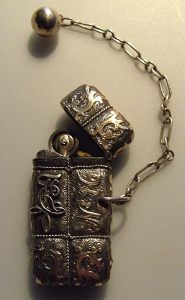
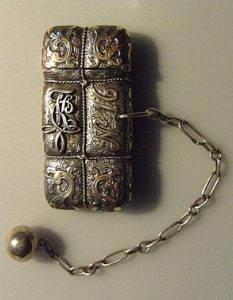
|
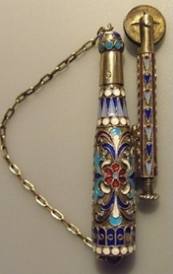
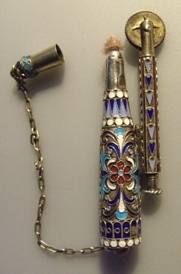
|
St. Petersburg 1908-1917
Iron guilloche, gold, silver, very high quality
No maker, only chain assay marked 84 Zolotniki
The form is a parcel tied up with string
|
Moscow 1908 - 1917
Enamel Cloisonné, Silver gilded, 84 Zolotniki
Maker: Schelaputin, Dmitrij Maksimowitsch
|

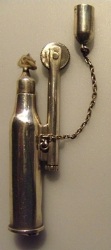
|
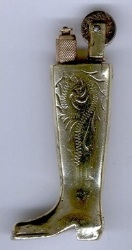
|
Moscow 1908 - 1917,
Silver, 84 Zolotniki
Maker: Fuld, Alexandr Iosifowitsch
|
Brass, unknown maker, ca.
1920
|
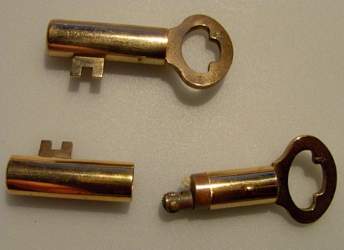
|
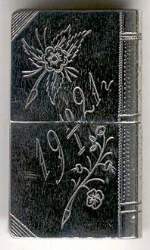
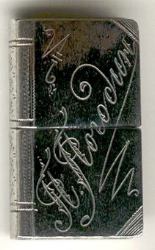
|
Brass, unknown maker, ca.
1920
|
nickel,
unknown maker, ca. 1921
|
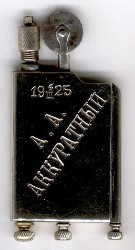
|
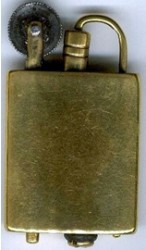
|
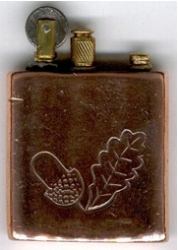
|
nickel
Unknown maker 1925
|
Soviet GULAG
|
Soviet camp W27439
for German POW
|
|
|
 ASSOCIATION OF SMALL COLLECTORS OF ANTIQUE SILVER
ASSOCIATION OF SMALL COLLECTORS OF ANTIQUE SILVER ASSOCIATION OF SMALL COLLECTORS OF ANTIQUE SILVER
ASSOCIATION OF SMALL COLLECTORS OF ANTIQUE SILVER